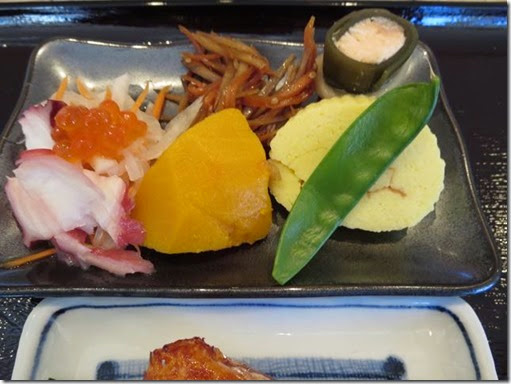Since we had some very cold wintery days recently, we enjoyed warm sake several times. One such evening, we had the Japanese classic of hot sake with oden. After I found Hakushika junmai and junmai ginjo 白鹿純米、純米吟醸 (sake in a box) at our Japanese grocery store, these have become our favorite sake served warm or "kanzake" 燗酒. The sake sold this way is usually not the best sake but is still good quality as is the case with these two. Also sake sold in a box costs significantly less than the same sake sold in a bottle. For these reasons, we think these are a good buy. (Other packaging variations may include "cup-sake" or "sake-in-a-can". Cup-sake could be even daiginjo class).
Of course on a cold winter evenings, warm sake is best paired with either oden おでん or nabe 鍋dishes. This time, I made oden. Usually boiled eggs in oden end up hardboiled even if they are soft boiled when put in the broth. So this time I made soft boiled eggs with runny yolks which I kept separate from the rest of the oden, then just 5 minutes before serving I warmed them in the broth. I put mochi in the deep fried tofu pouches or "abura-age" 油揚げ. Instead of regular potato I used "sato imo" 里芋 or taro.
Although the eggs did not absorb the broth's flavor, the runny yolks were nice for a change. The cylindrical item is fish cake stuffed with burdock root or "Kobo-ten" ごぼう天. The rest of the items were tofu, shitake mushroom, blanched broccoli and carrot.
On a cold winter evening, this is very warming and comforting.
Showing posts sorted by relevance for query おでん. Sort by date Show all posts
Showing posts sorted by relevance for query おでん. Sort by date Show all posts
Tuesday, January 28, 2020
Monday, January 27, 2014
Japanese winter stew with octopus legs たこ入りのおでん
I posted that we got 2lb whole octopus for the New Year. I made this Japanese winter stew or "oden" おでん with the octopus. The way oden was made is exactly the same as my previous post, but I added the tips of the octopus legs on skewers to the oden. When octopus legs are cut for sashimi or other use, the tips remain. I usually cut the tips into small chunk or "butsu-giri" ぶつ切りand dress them with "sumiso" 酢味噌. I serve them as contrast in texture with the sliced octopus. This time, I decide to use the tips of the legs in oden.
As I add items to the oden pot, I usually end up having too much oden. So I restrained myself and did not add any fish cakes just the octopus legs, boiled eggs, tofu, daikon, konnyaku 蒟蒻, and shiitake mushroom.

This one small serving with a dab of Japanese hot mustard. Since I left the octopus legs for long time in the pot, they were rather tender and also imparted a nice “fresh ocean” flavor to the broth.

The picture below shows how I cut the tips of the legs and then skewered them. You do not have to skewer them but it looked nice and it prevents them from curling up when they cook.

This is a very good way of using tips of the octopus especially on a cold winter day.
As I add items to the oden pot, I usually end up having too much oden. So I restrained myself and did not add any fish cakes just the octopus legs, boiled eggs, tofu, daikon, konnyaku 蒟蒻, and shiitake mushroom.

This one small serving with a dab of Japanese hot mustard. Since I left the octopus legs for long time in the pot, they were rather tender and also imparted a nice “fresh ocean” flavor to the broth.

The picture below shows how I cut the tips of the legs and then skewered them. You do not have to skewer them but it looked nice and it prevents them from curling up when they cook.

This is a very good way of using tips of the octopus especially on a cold winter day.
Friday, March 5, 2010
Japanese winter stew おでん
"Oden" おでん is classic Izakaya food. Yakitori 焼き鳥 and oden are the two main pillars of drinking food in Japan. Although any given Izakaya may serve up oden and/or yakitori among other items, there are drinking places specialized just in "oden" or "yakitori". Often I used to go to a drinking place that specialized in oden, "oden-ya" おでん屋, in Sapporo, called "Katsu-ya" かつや. The original and name-sake proprietor has passed away, and it has moved from a quaint blind alley off the Oodouri 大通 to the basement floor of a building near Sapporo train station. One of her daughters has taken over the business. It appears that the quality of the oden and atmosphere are unchanged. It is still a very cosy welcoming place and always very crowded with salary men on the way home. I found the image of inside Katsuya on the Internet in one of the blogs (hope the author will not mind my using his picture here). Once, my wife and I visited Katsuya in this new location long time ago when we visited Sapporo. This picture really brings back memories.
Broth: I used a piece of kelp (2x8 inches) which was first soaked in water for 30-40 minutes or longer (4 cups or about 1 liter) or whatever amount is appropriate for your vessel. I then put the pot on a medium low flame. When it comes to a boil, I reduce the flame to very low and add dried bonito flakes or "Kezuri (katsuo)bushi" 削り(鰹)節. I use a special large teabag-like bag called "Dashi bukuro" だし袋 in which the bonito flakes are placed and the opening sealed (about 20 grams). This is just for convenience so that I do not have to filter the broth later (I usually take out the bag with bonito flakes when the vegetables are all cooked). You could just put the bonito flakes in the pot and simmer for 10-20 minutes and then strain using a fine mesh strainer. You could also set aside a portion of unseasoned broth just in case the broth get too salty.
Daikon 大根: Daikon is a must in any oden and requires some preparation. I peel the skin and cut the peeled diakon into 1 to 1.5 inch thick rounds and bevel the sharp edges, mentori 面取り. I pre-cook the daikon in a separate pot with enough water to cover the daikon and one pinch of raw rice grains for 20-30 minutes and then transfer to the oden pot.
Carrot and potato: These items may not be most common items in oden but "Katsu-ya" served them and we like them very much. Just peel and cut into the size you like (not too small) and bevel the sharp edges and place it in the oden pot.
Boiled eggs: This is also the must-have item. I just boil eggs for 10 minutes, peel and place them in the oden pot.
Konnyaku コンニャク: It does not have much taste on its own and it is mostly for texture. most of Westerners will not appreciate this item but it is nonetheless a classic oden item. I make multiple shallow crosshatch cuts on both sides so that the broth will penetrate better. I then cut it into bite sized pieces (I cut this into a triangle which is traditional) then, par-boil it in plenty of water for one or two minutes. I drain the konnyaku and then place it in the oden pot.
Seasoning: At this point, I season the broth. I use soy sauce, mirin, sake and salt (I use salt to prevent the broth from becoming too dark which would happen if I added too much soy sauce to get the desired saltiness especially because I usually use a reduced salt soy sauce. Alternatively, you could use "light colored" soy sauce or "usukuchi shouyu" 薄口醤油. You may even like a dark broth, in that case, just use soy sauce. I cannot give you an exact amount but I will err on the side of under seasoning and go light on mirin (Vegetables add some pleasant natural sweetness). You can always adjust the seasoning later.
Chikuwa 竹輪: Cylinder-shaped fish cake (ground white fish meat with some binder and seasoning is boiled and lightly grilled and is sold frozen here in the U.S.) with a hole in the center shaped like a bamboo. Cut diagonally in the center (in the picture above it is shown in the center of the pot above the Daikon. In the picture below it is shown on the lower right).
Ganmodoki がんもどき: Deep fried oval patty made of tofu, egg white, black sesame seeds and other shredded vegetables (tan oval item with black specs -sesame seeds- in the picture below). Often, this is shortened as "ganmo".
Mochi in fried tofu pouch or mochi kinchaku 餅巾着: "Kinchaku" is a transitional Japanese purse. If you stuff anything in a tofu pouch or "Abura-age" 油揚げ, it is called "Kinchaku". Mochi 餅 is a rice cake made of pounded cooked rice. I cut one end of a small rectangular abura-age and place mochi inside and close the pouch with tooth picks (This pouch is shown between the eggs and kelp in the picture above). This is the same type of preparation I do for the new year soup. (If you are an oden officinado, you would order this item using its short form name "mochikin"). After 5-10 minutes, the mochi will become soft and sticky but contained in the tofu pouch it is easier to eat. (They are seen in the picture above between eggs and kelp.)
Tied kelp 結び昆布: I happend to find this kelp preparation in a bag (cut in small size, tied in knots, steamed and dried) called "Musubi Konbu" or tied kelp at a Japanse grocery store. I put them in the pot after hydrating for 15 minutes. It does not taste that good and disintegrated after some time so this is the first and will be the last time I use this.

In the above picture, the dark triangles are konnyuku, tan oval ones with black specks (sesame seeds) are ganmodoki and tubes on the right are chikuwa. In the back, you see potato, kelp, and carrot.
Just 10 minutes before serving, I add large cubes of tofu. Tofu should just be warmed through. As seen in the above picture, I garnish the tofu with chopped chives (or scallion). the daikon here is very soft and you can cut it with just chopsticks. The yellow stuff at the far right corner is Japanse mustard which is very hot but a necessary condiment for oden.
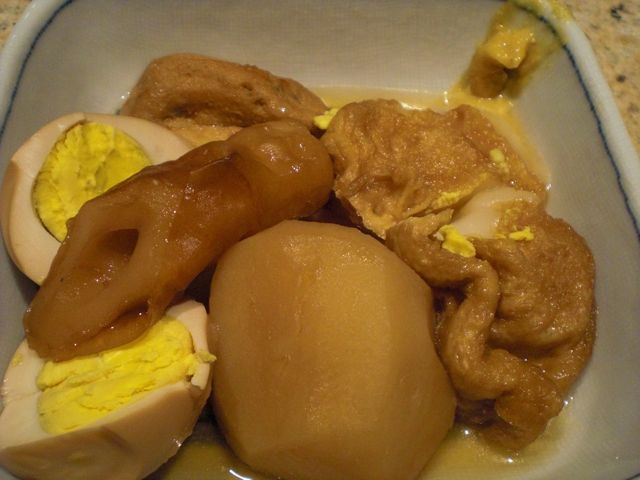
Eggs are wonderful especially the egg yolks mixed into some of the broth and mustard. In the above picture, on the right is "mochi kinchaku", which is cut and showing the mochi inside. Between the eggs is chikuwa and the center front is potato.
Just 10 minutes before serving, I add large cubes of tofu. Tofu should just be warmed through. As seen in the above picture, I garnish the tofu with chopped chives (or scallion). the daikon here is very soft and you can cut it with just chopsticks. The yellow stuff at the far right corner is Japanse mustard which is very hot but a necessary condiment for oden.
This is a perfect dish for cold winter days with sake. Warmed sake is the classic accompaniment but we like cold sake even with oden. Depending on what you like, you could use many other items in oden such as tough sinewy parts of beef, "Gyu-suji" 牛筋 cooked for long time, octopus leg "Tako" 鮹 (these are Kansai 関西 or West of Japan items), thick Japanese omelets with crab meat ("Kanitama" かに玉), many other types of fishcakes especailly white soft square ones called "Hanpen" はんぺん, and satsuma-age 薩摩揚げ. A bit unusual are "tara no shirako" タラの白子, which is the sperm sac of cod fish (It does not sound appetizing but it does taste very good), a Japanese style stuffed cabbage ロールキャベツ, a type of small conch or sea snail called "Tsubu" つぶ and so on. We really like oden but only problem for us is that there are so many goodies in one pot and it fill us up too quickly.
Thursday, February 23, 2012
Deep fried tofu pouch stuffed with chicken and bean sprouts 鶏笹身ともやしの巾着
We were having some very cold and windy days with a bit of snow (just a dusting with some wind-blown snow accumulation). We also had two small abura-age 油揚げ or deep fried tofu pouches left after making inarisuzhi いなり寿司. I decide to make a simplified version of Japanese winter stew or oden おでん. Please see more information in my previosu post for oden. Instead of the usual mochi-kin 餅巾 or mochi rice case in abura-age, I thought I would make pouches stuffed with pork, onion and bean sprouts. Especially since I had leftover blanched bean sprouts from making cellophane noodle salad. Whenever you stuff the abura-age pouch, the dish is caled "kinchaku" 巾着 which is the name for a traditional Japanese pouch. After I started the preparation, I realized I did not have any pork but I had two bone-in skin-on split chicken breasts which needed to be dispatched soon--before they went bad. I removed the breasts and two tenderloins. I made the breasts into microwave "sakamushi" 酒蒸し chicken. I made the stuffing for the tofu pouches from the chicken tenderloins adding shiitake and bean sprouts. The remaining breast bones were used to make the broth for the oden.
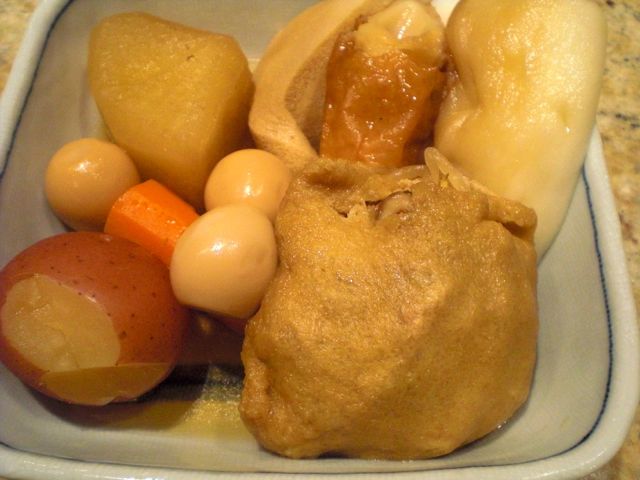
Revealing the content of the pouch.
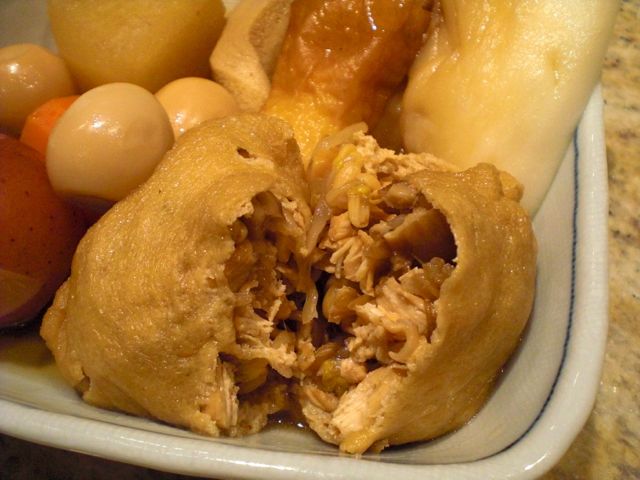
Broth: I took a shortcut and used a dashi pack with dried fish, bonito flakes, kelp. I also added the bones from the chicken breasts as well (which was not the usual way of making broth for oden). In a pot, I added about 4 cups of water and a dashi pack. After simmering for 5 minutes, I added the chicken bones and simmered for another 20-30 minutes. I skimmed off any scum that appeared on the surface from the chicken bones. After I removed the bones and dashi pack, I strained the broth. I returned the broth to a donabe earthenware pot. I seasoned it with sake (3 tbp), mirin (3 tbs), soy sauce (2 tbs) and usukuchi 薄口 or light colored soy sauce (2 tbs). Later I adjusted the seasoning by adding a bit more light colored soy sauce.
Here is a serving of oden; the stuffed pouch is in the foreground accompanied by diakon, potato, carrot, quail eggs, freeze-dried tofu or shimi-dufu, chikuwa and hanpenn. I admit this does not look particularly photogenic.
Stuffed "kinchaku" pouch: The amounts of the ingredients are not accurate since I did not measure. I made just enough to stuff the two rectangular pouches seen below. I sautéed strips of chicken tenderloin (two), fresh mushrooms (5 small, cut into thin strips), blanched bean sprouts (one handful, probably 1/2 cup) in olive oil with a dash of sesame oil. I also added finely chopped ginger (1/8 tsp) and Japanese red pepper flakes. After few minutes of sautéing, I seasoned it with sake (2 tbs) and soy sauce (1 tbs). I braised it until the liquid was also most all gone.
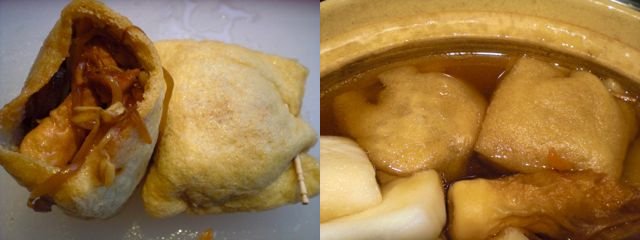
After the stuffing cooled enough to handle, I stuffed the pouches and closed them with a tooth pick (left on the image above). I simmered them in the oden broth with the other items (probably for about one hour. The broth should not boil or even simmer during this process).
Despite the change of plan the midway through, this was not too bad. Although I probably prefer my original intent of bean sprouts, onion, and ground pork, this kinchaku was not bad at all.
Despite the change of plan the midway through, this was not too bad. Although I probably prefer my original intent of bean sprouts, onion, and ground pork, this kinchaku was not bad at all.
Thursday, February 9, 2012
Fried tofu ball がんもどき
Ganmodoki is one of the common items used in oden おでん. Usually I buy this ready made and frozen but since I had 1/2 tofu left over and happened to have the other ingredients to make "ganmodoki" or "ganmo" for short, I gave it a go. Hot freshly fried ganmo is very different from what you eat as an oden item.
Here I served it hot with grated ginger and soy sauce. (You can see a ginko nut peeking out of the cut surface.) There appear to be many theories as to the origin of the name. The corresponding kanji letter for ganmodoki is 雁擬き meaning "imitation goose" but this certainly does not resemble, in any way, shape or form, goose meat.

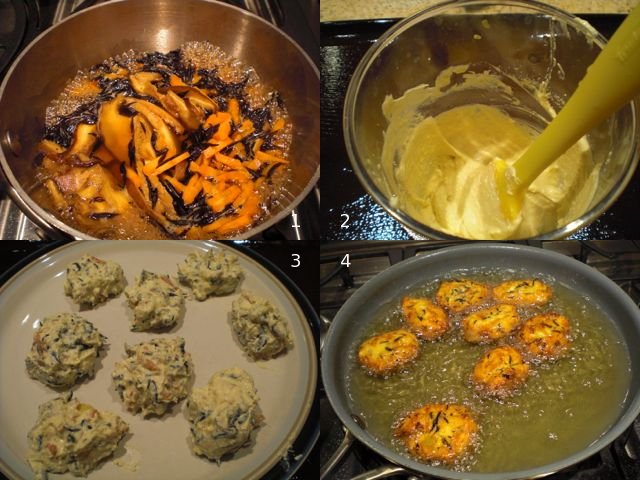 I deep fried it in 170C (340F) vegetable oil until golden (#4, turning a few times, total time of 4-5 minutes).
I deep fried it in 170C (340F) vegetable oil until golden (#4, turning a few times, total time of 4-5 minutes).
I had 1/2 a block of soft tofu to use. I wrapped it in a paper towel and microwaved it for 1 and half minutes and let it cool down, allowing the excess water to be absorbed into the paper towel. I placed the tofu and a whole egg (1 large) in a plastic blending container and homogenized using an immersion blender (#2 in the image below). You can use a food processor or Japanese mortar, suribachi すり鉢, for this as well.
Other ingredients included; dried shiitake mushroom (1 large, hydrated, stem removed and thinly sliced), black sea weed called "hijiki" ひじき (dried 1 tbs), gobou (1/4 tail end, leftover from the New Year) and carrot (1/4 medium). For hijiki sea weed, this time, I used "me-hijiki" 芽ひじき which is shorter and smaller than long hijiki or naga-hijiki 長ひじき I posted before. After hydration (with several changes of water for 30 minutes), hijiki increased in volume by almost 10 fold. I squeezed out the excess moisture and combined with shredded gobout and carrot.* I added the soaking liquid from the shiitake (100ml) and simmered (#1 in the image below). I added mirin (2 tbs) and soy sauce (1 tbs) and further simmered on a low flame for 5-10 minutes until almost all the liquid was gone. I let it cool down and further removed any remaining liquid by squeezing. I added the mixture to the homogenized tofu and added potato starch (1 tsp or a bit more depending on the moisture level) and mixed well. Since I seasoned the vegetables, I did not add salt to the batter.
Moistening my hands with vegetable oil, I made small round disks (eight 2 inch diameter) and I also inserted ginko nuts (from a can) into the center (#3 in the image below). The batter was very soft and sticky. You could use two spoons in a manner similar to making quenelle and directly drop it in the oil.
* These were cut in "sasagaki" ささがき. In Japanese curinary parlance, sasagaki is to shave off vegetables (mostly thin long items such as gobou) as though you are sharpening a pencil. Supposedly, the shape of the resulting pieces resembles small bambo ("sasa" 笹) leaves.
Homemade and hot freshly fried ganmo has an all together different taste and texture from the frozen variety we are used to. Hot and crunchy on the outside you can't go wrong. Although, we have to admit, this does not remind us of goose meat, it is quite good on is own right. A perfect drinking snack especially with cold sake.
Friday, September 2, 2011
Rice cake "isobe" roll お餅の磯辺巻き
"Mochi" 餅 is steamed glutenous rice pounded into paste which is shaped into discs with one convexed side ("maru-mochi" 丸餅) or rolled out ("noshi-mochi" 伸し餅) and cut into small rectangles ("kiri-mochi" 切り餅). Instead of using a traditional wooden mallet or "kine" 杵 and mortar or "usu" 臼, nowadays, mochi can be made at home using a smal mochi making machine and, apparently, mochi can be made using a Kitchen-Aid mixer with a dough hook. The easiest way, however, is to buy packaged commercially produced mochi at a Japanese grocery store which is the route we usually take.
Especially If mochi is made at home, you could enjoy it while it is still warm and soft, however, more commonly, it is allowed to harden. Hardened mochi cakes can last at least a few weeks or longer and easily can be transformed back into a soft and edible state by boiling or grilling. After all, it does have its origins as a preserved food or emergency ration. Although it is eaten year around and many types of Japanese crackers are also made from mochi, it is a traditional New Year food (so that house wives do not have to cook rice for at least the first 3 days of New Year). I have posted mochi in New Year soup called "Zouni" 雑煮 and in a deep fried tofu pouch for "oden" おでん called "mochi kinchaku" 餅巾着 or "mochi-kin" for short.
My wife told me that this is the very first Japanese food she ever ate. While at college she shared a dormitory house with a girl who grew up in Japan. Her family sent her a "CARE" package for New Year which included "mochi" and nori to wrap it in. My wife tasted it and immediately liked it. In her enthusiasm to share her new discovery she raced to take a piece to another friend who scowled at it critically and said, "wait, take the paper off first," referring to the nori. Every time I serve this dish my wife nostalgically laughs about that comment. In any case, this is not a bad ending for the evening of an Izakaya feast, although I do not know any Izakaya which would serve a mochi dish like this.
One of the simplest and quickest ways to prepare mochi, however, is this dish called "Isobemaki". "Isobe" means "seashore" and "maki" means "wrap" or "roll", since it is wrapped in dried nori sea weed. We had this "isobemaki" 磯辺巻き one evening (one each) as an ending dish or "shime" dish. The taste brought me back to my childhood. Most of the Japanese families used to eat mochi more in quantity, in frequency, and for a longer period in New Year. When I was a kid, we used to eat mochi for breakfast and lunch at least in the first 3 days of New Year. We used to eat "isobemaki" mochi as lunch.

We bought a package of "kiri-mochi" for the past New Year. This is individually sealed in a plastic wrap and lasts for long time in the refrigerator. So one night, I decided to make this dish. It is not even a recipe but here it is.
Toasting mochi: Traditionally, mochi is grilled on a charcoal braiser but, in modern days, a toaster oven is the best choice. It tends to become very sticky so I used a small removable metal grate which prevents the mochi from sticking to the grate of the toaster oven. The small grate can be easily cleaned by soaking in water first. I toasted the mochi like a piece of bread but I kept an eye on it closely. When it started puffing up I stopped cooking and took it out.
Sauce: This is sometimes called "sato(u)jouyu" 砂糖醤油 and can be very easily made. It is a mixture of sugar and soy sauce. The ratio is up to your taste but I use 1:1 rato. I microwave it briefly (a few seconds) so that sugar melts completely.
After I coated all sides of the cooked mochi, I wrapped it with a rectagular portion of dried nori sheet. If you hold the nori sheet on the mochi for a few seonds with chopsticks, it will stick to mochi like you see above. As you eat, you could dip it in the sauce if you like.
My wife told me that this is the very first Japanese food she ever ate. While at college she shared a dormitory house with a girl who grew up in Japan. Her family sent her a "CARE" package for New Year which included "mochi" and nori to wrap it in. My wife tasted it and immediately liked it. In her enthusiasm to share her new discovery she raced to take a piece to another friend who scowled at it critically and said, "wait, take the paper off first," referring to the nori. Every time I serve this dish my wife nostalgically laughs about that comment. In any case, this is not a bad ending for the evening of an Izakaya feast, although I do not know any Izakaya which would serve a mochi dish like this.
Tuesday, December 9, 2014
Egg in a pouch 卵の袋煮
In general Japanese are fond of hen's eggs (or for that matter any kind of eggs either bird or fish). This ranges from "raw" eggs on rice 卵かけ御飯, omelet (either Western style or Japanese "Dashimaki" 出し巻き卵), onsen egg 温泉卵, "tamago-toji" 卵とじ (binding topping items with beaten eggs which was lightly cooked like in Donburi どんぶり) and so on. We like eggs but try not to eat too many. When it comes to eggs the one thing we do not like is hard boiled eggs which have been boiled to the point where a green layer of sulfur appears around a very hard egg yolk. One way to avoid this is to make a soft- or medium boiled egg, peel it and then simmer it in a broth such as in oden おでん. The yolk gets totally cooked and becomes creamy with no sulfa-rings. The same thing happens with this dish "egg-in-a-pouch" or "Tanago no fukuro-ni" 卵の袋煮.
"Fukuro" means "pouch" which in this case is made of deep fried tofu or abra-age. It is made by cracking a raw egg into the deep fried tofu pouch, sealing it with a tooth pick and simmering it in broth. The result is a creamy egg yolk without the sulfur ring but with the added texture and flavor of the deep dried tofu. Besides, busting into it is like opening a surprise package particularly if you do not know what is inside the pouch.
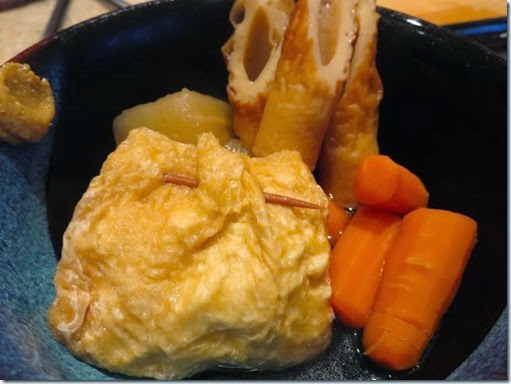
This dish is usually cooked in "nitsuke" 煮付け but I made it as part of oden this time. The above are daikon, carrots, "chikuwa" 竹輪 fish cake and the "egg in a pouch" served with Japanese hot mustard.

When you cut into it, you can see the totally cooked and creamy yolk without the green sulfa ring. My wife said, that, although this is very good, she prefers a simple boiled egg in oden.
"Fukuro" means "pouch" which in this case is made of deep fried tofu or abra-age. It is made by cracking a raw egg into the deep fried tofu pouch, sealing it with a tooth pick and simmering it in broth. The result is a creamy egg yolk without the sulfur ring but with the added texture and flavor of the deep dried tofu. Besides, busting into it is like opening a surprise package particularly if you do not know what is inside the pouch.

This dish is usually cooked in "nitsuke" 煮付け but I made it as part of oden this time. The above are daikon, carrots, "chikuwa" 竹輪 fish cake and the "egg in a pouch" served with Japanese hot mustard.

When you cut into it, you can see the totally cooked and creamy yolk without the green sulfa ring. My wife said, that, although this is very good, she prefers a simple boiled egg in oden.
Monday, November 30, 2015
Simmered Nagaimo and Fried tofu 厚揚げと長芋の煮付け
I bought atsu-age 厚揚げ at our Japanese grocery store one weekend thinking I would either add it to oden おでん or just grill it in the toaster oven but neither happened. I realized "the best tasted before date" was a few day AGO. So, instead of grilling, I switched to “emergency mode” and quickly made this dish which is like oden but has only a few items.
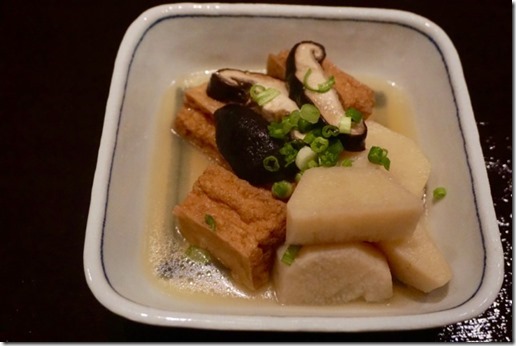
Again, I made this with what I had on hand. I had half a nagaimo 長芋 in the refrigerator left over from when I made yamakake 山かけ more than a week ago. I also had some nice thick shiitake mushrooms which I also bought at the Japanese grocery store sometime ago that needed to be used.
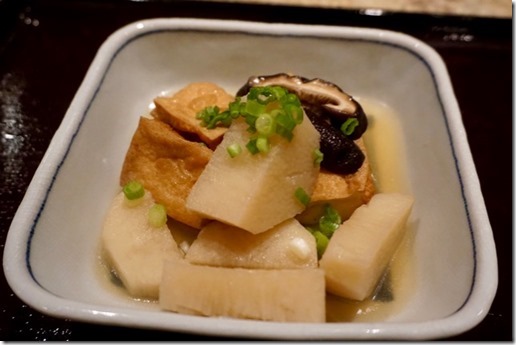
So this is the dish I came up with.
Broth: I made broth from dashi pack (dried bonito and kelp), added sake, mirin, light colored soy sauce. I supplemented the soy sauce with salt added in increments as I tasted. I used the salt because I did not want the nagaimo to become too dark as it would have if I used all soy sauce but I also wanted properly seasoned simmering broth. (I ended up using about 1/2 tsp of Kosher salt).
Atsu-age: I placed them in a colander and poured hot water over them (from the instant hot water dispenser which is connected to Culligan reverse-ososis filtering system) to remove excess oil. I then cut them in half.
Nagaimo: I peeled and cut into 1 inch-thick rounds and then halved them. I immediately soaked in water with a splash of rice vinegar.
Shiitake mushrooms: I removed the stems and cut into half inch slices (this was rather large and thick shiitake, possibly from Japan).
I placed the nama-age, nagaimo and shiitke in the broth and gently simmered it for 40-50 minutes. I served it in a bowl with a bit of the simmering broth and garnished it with chopped scallion.
This was a good combination. When cooked, the nagaimo looses it's sliminess and has a nice crunchy texture. This was perfect for cold sake.

Again, I made this with what I had on hand. I had half a nagaimo 長芋 in the refrigerator left over from when I made yamakake 山かけ more than a week ago. I also had some nice thick shiitake mushrooms which I also bought at the Japanese grocery store sometime ago that needed to be used.

So this is the dish I came up with.
Broth: I made broth from dashi pack (dried bonito and kelp), added sake, mirin, light colored soy sauce. I supplemented the soy sauce with salt added in increments as I tasted. I used the salt because I did not want the nagaimo to become too dark as it would have if I used all soy sauce but I also wanted properly seasoned simmering broth. (I ended up using about 1/2 tsp of Kosher salt).
Atsu-age: I placed them in a colander and poured hot water over them (from the instant hot water dispenser which is connected to Culligan reverse-ososis filtering system) to remove excess oil. I then cut them in half.
Nagaimo: I peeled and cut into 1 inch-thick rounds and then halved them. I immediately soaked in water with a splash of rice vinegar.
Shiitake mushrooms: I removed the stems and cut into half inch slices (this was rather large and thick shiitake, possibly from Japan).
I placed the nama-age, nagaimo and shiitke in the broth and gently simmered it for 40-50 minutes. I served it in a bowl with a bit of the simmering broth and garnished it with chopped scallion.
This was a good combination. When cooked, the nagaimo looses it's sliminess and has a nice crunchy texture. This was perfect for cold sake.
Saturday, May 8, 2010
"Hanpen" fish cake sauteed in olive oil はんぺんのオイル焼き
Japanese have many variations of fish cakes such as kamaboko 蒲鉾, Satsuma-age 薩摩揚げ etc. "Hanpen" 半片 is the most dedicate in taste and texture among Japanese fish cakes. It is usually a square shaped, white and light in texture, made of white fish meat (mostly Alaskan Pollock or すけとうだら) paste called "surimi" すり身, egg white and grated mountain yam 山芋. It is boiled rather than deep fried. It is a very common item in oden おでん but I did not have it when I made oden. Besides serving it as oden, I use hanpen in leu of "surimi" すり身 when making a New Year sweet rolled omelet called "datemaki" 伊達巻き. I just bought frozen hanpen in a Japanese grocery store and decided to serve it very simply.
First, I thaw one hanpen and cut it into 4 rectangles. Add 1 tsp of olive oil and thin slices of garlic (one medium clove) to a non-stick frying pan on a low flame. Slowly fry the garlic turning once until nicely brown (do not burn). Remove the garlic and set aside on a paper towel. I, then, place 4 pieces of hanpen and sauté for one minutes or until nicely light brown, turn it over and cook another 1 minute. I served with blanched broccoli rabe dressed with mustard soy sauce (Japanese mustard from a tube, sugar and soy sauce), topped with the garlic chips, which I set aside previously, and chiffonade of perilla. Add a small amount of soy sauce before eating. If you like you could just use butter and soy sauce instead of olive oil and garlic.
This is a very simple quick dish but a perfect accompaniment for a drink. The texture and taste of hanpen are so delicate but goes very well with olive oil, garlic and perilla.
Sunday, June 14, 2015
Cold salmon and simmered vegetables 冷製サーモンと野菜の煮付け
This was a starter dish for one evening made up of leftovers. Cold salmon was leftover from pan fried and oven finished salmon filets. Straight out of the oven, the skin was nicely crispy and we preferentially ate all the skin leaving good sized chunks of meat behind as leftovers. I simply served these salmon chunks cold with baby arugula dressed with honey mustard dressing.
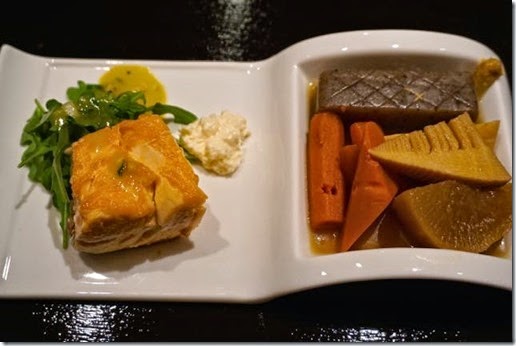
On the right are simmered vegetables which started life as "oden" おでん. I served the oden several times stretching it out by adding boiled eggs, tofu, and fish cakes. These carrots, daikon, and konnyaku コンニャク were the remaining survivors of this never ending oden, I added a top portion of boiled bamboo shoot (leftover from when I made mu shu pork). I seasoned the oden broth further by adding soy sauce and mirin and made the remaining veggies to "Nitsuke" 煮つけ (compared to oden, nitsuke usually has much stronger seasoning).
Finally all the leftovers have been accounted for and served. I do not remember what we drank with this but either red wine or sake would be just fine.
Tuesday, November 24, 2015
Sautéed baby octopus タコのソテー
This is one of the dishes I made from a package of frozen small octopuses (octopi?) (we’ll call them guys) which I found in the frozen case of our Japanese grocery store. The package indicated this was a product made in the U.S. for an Italian American clientele. The package contained three little guys and I used two in my oden おでん (I did not take pictures but I posted octopus in oden previously). I made one into this dish. This was sautéed in olive oil and seasoned with salt and black pepper. We had this with red wine.
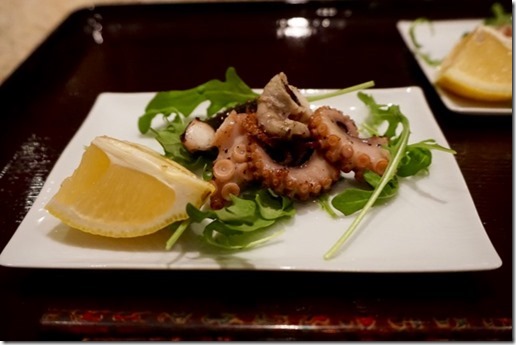
I washed and salted the thawed guys. I kneaded them in a metal bowl in an attempt to tenderize.
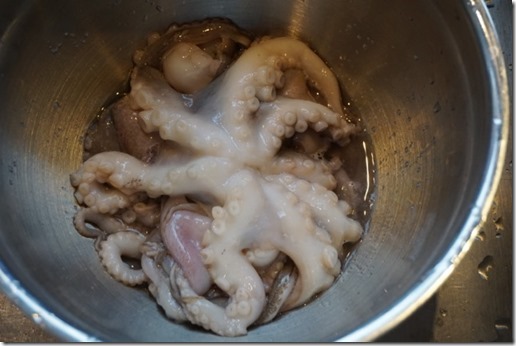
I then boiled them in water with added salt, sake, and a small splash of rice vinegar for 30 minutes on low heat.
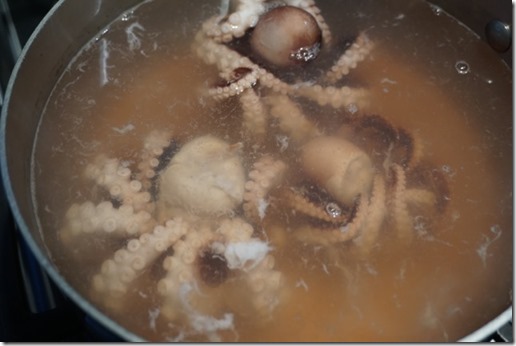
After 30 plus minutes, the octopus shrank quite a bit.
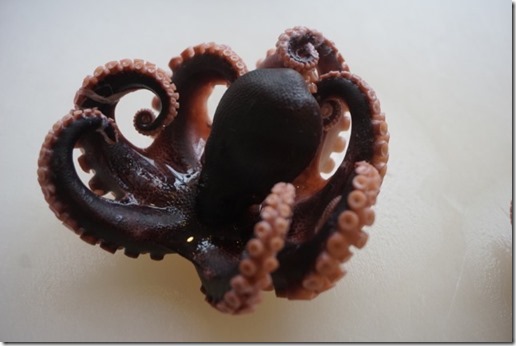
I cut two into several long pieces and placed then in my oden pot and simmered for 1 hour or so with other oden items. This was very tender and nice. The remaining one, I cut into bite sized pieces, placed them in a ZipLoc bag and added olive oil. I kept this in the fridge for a few days before we got back to it. I simply sautéed it in olive oil and seasoned it rather severely with salt and freshly ground black pepper.

The octopus was very tender and the flavor profile went well with wine. If I find a similar package again I will definitely buy one but so far I have not seen this item in the Japanese grocery store.

I washed and salted the thawed guys. I kneaded them in a metal bowl in an attempt to tenderize.

I then boiled them in water with added salt, sake, and a small splash of rice vinegar for 30 minutes on low heat.

After 30 plus minutes, the octopus shrank quite a bit.

I cut two into several long pieces and placed then in my oden pot and simmered for 1 hour or so with other oden items. This was very tender and nice. The remaining one, I cut into bite sized pieces, placed them in a ZipLoc bag and added olive oil. I kept this in the fridge for a few days before we got back to it. I simply sautéed it in olive oil and seasoned it rather severely with salt and freshly ground black pepper.

The octopus was very tender and the flavor profile went well with wine. If I find a similar package again I will definitely buy one but so far I have not seen this item in the Japanese grocery store.
Sunday, February 8, 2015
Grilled cheese Mochi rice cake 焼きチーズ餅
As a Japanese, I have to have mochi rice cakes 餅 on the new year. But, as is the case with many modern families in Japan, we only eat a small portion of the mochi we buy for the holiday. It is a “must have” for the Ozouni お雑煮 New Year's soup and we used it several times in oden おでん but we have mochi leftover even though we bought a smallest package (containing 10-15 mochi squares wrapped individually).
As a result, many Japanese on-line cooking sites have recipes for left over mochi. This recipe for grilled cheese mochi looked really interesting and I decided to make it for lunch. The great idea of this recipe is that, on one side, the cheese is melted and browned and on the other side, slightly melted, thus, you can enjoy two different cheeses.
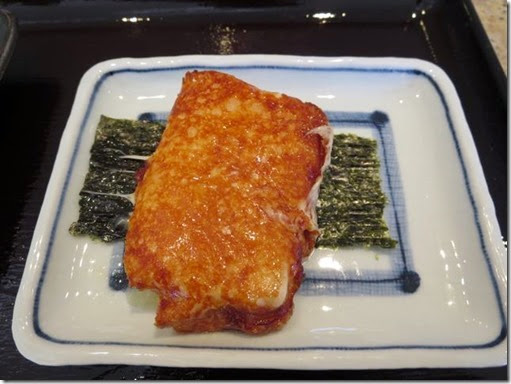
To make this, I started cooking the mochi in a frying pan with a small amount of olive oil on low flame turning several times (for about 5 minutes) until the mochi soften and puff up slightly. I put the cheese slices on top (I used applewood smoked mozzarella cheese). When the cheese softened, I flipped the mochi over and placed another slice of cheese on the other side (now on the top). I let it cook until the bottom layer of the cheese melted, spread out a little and started browning. At the very end, I added a tiny amount of soy sauce. I placed the grilled cheese mochi on a small sheet of nori dried seaweed (above picture). When we made this the second time and I served it on a much larger nori sheet.
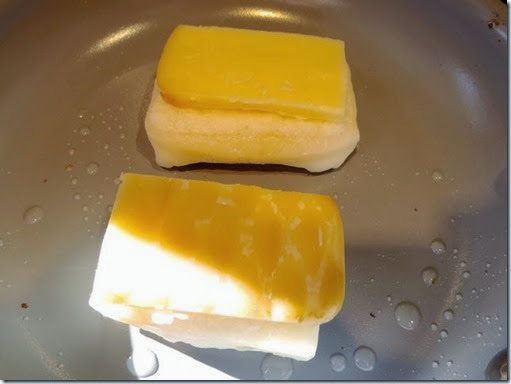
Since we had the leftover from new year's dishes, I also served some.

From left, daikon namasu garnished with ikura salmon roe, thinly sliced boiled octopus, kimpira burdock root, simmered Kabocha pumpkin, kelp salmon roll and New Year's omelet roll.
The combination of browned and soft cheeses, starch, soy sauce and nori cannot go wrong. This is a wonderful recipe and we will be consuming more mochi than ever this year. .
As a result, many Japanese on-line cooking sites have recipes for left over mochi. This recipe for grilled cheese mochi looked really interesting and I decided to make it for lunch. The great idea of this recipe is that, on one side, the cheese is melted and browned and on the other side, slightly melted, thus, you can enjoy two different cheeses.

To make this, I started cooking the mochi in a frying pan with a small amount of olive oil on low flame turning several times (for about 5 minutes) until the mochi soften and puff up slightly. I put the cheese slices on top (I used applewood smoked mozzarella cheese). When the cheese softened, I flipped the mochi over and placed another slice of cheese on the other side (now on the top). I let it cook until the bottom layer of the cheese melted, spread out a little and started browning. At the very end, I added a tiny amount of soy sauce. I placed the grilled cheese mochi on a small sheet of nori dried seaweed (above picture). When we made this the second time and I served it on a much larger nori sheet.

Since we had the leftover from new year's dishes, I also served some.

From left, daikon namasu garnished with ikura salmon roe, thinly sliced boiled octopus, kimpira burdock root, simmered Kabocha pumpkin, kelp salmon roll and New Year's omelet roll.
The combination of browned and soft cheeses, starch, soy sauce and nori cannot go wrong. This is a wonderful recipe and we will be consuming more mochi than ever this year. .
Sunday, July 22, 2012
Fried Marinated "Kon-nyaku" こんにゃくの竜田揚げ
Kon-nyaku. 蒟蒻, some times spelled “konjac ”, and called “Devil’s tongue” in English, is a rather peculiar food item made out of the starch extracted from a particular vegetable root. It has the consistency of hard jelly and practically no taste and no calories. Japanese traditionally use it as an oden おでん item. I have posted a few dishes using konnyaku. This is another konnyaku dish but, with the deep frying it loses its no calorie status. You do not find this type of dish anywhere but at an Izakaya.

I made two different versions which mostly provide differences in texture rather than taste. I served this dish on a funky triangular shaped plate on which a folded “tempura shikishi 天婦羅敷き紙 paper fits perfectly. I garnished it with deep fried and crispy parsley and sprinkled single flavored Japanese red pepper flakes or “Ichimi tougarashi” 一味唐辛子.

Preparation of konnyaku: I first washed and drained one cake of konnyaku (#1 below). To make two versions, I first divided one cake into two equal portions. For one half, I halved the thickness by slicing horizontally as I pressed down using my palm flat on the surface of the konnyaku. I then applied a series of shallow cuts obliquely in one direction, turned it around and added another series of cuts perpendicular to the previous cuts (#2 below). I then turned the pieces over and did the same cuts on the other side. You need to be careful not to cut through. I then cut it into I inch wide strips (#3 below). The other half of konnyaku, I just cut into 1 x 1.5 inch rectangles and poked multiple holes using a fork (#4 below). The idea here is to change the texture of knonyaku as well as make it absorb the marinades (see below) better. After this preparation, I placed the konnyaku pieces in a pot with amplen a amount of water on medium flame. I allowed it to come to the boil and cooked it for 2-3 minutes. I then drained and washed it in running cold water. This process removed a the peculiar (and rather unpleasant) smell characteristic of konnyaku.

Marinades: I made two marinades. Since no matter how you do it, konnyaku will not absorb marinades or any seasoning easily, I use undiluted soy sauce; one with grated ginger and one with yuzu-koshou. The amounts are again arbitrary but I used about 4 tbs soy sauce and 1/2 tsp each of grated ginger or yuzu-koshou. I marinated the cross hatched ones with the ginger and the rectangular ones with the yuzu koshou. I ended up marinating this for two days in the refrigerator for reasons beyond my control. Ordinarily just a few hours of marination would suffice. There is no worry of over marinating since the konnyak itself does not absorb, instead, the marinades are held in the holes and crevices I created in the konnyaku.
Just before frying, I took the konnyaku pieces out of the marinades and blotted the surface with a paper towel but did not squeeze out the absorbed marinades. I then dredged in potato starch or katakuriko 片栗粉.
Deep frying: I put peanut oil in a frying pan to the depth of about 1 inch on a medium flame. When the oil was 170C (325F), I deep fried the konnyaku pieces for 3 minutes or until the surface got crispy.
I served this piping hot with a sprinkling of one flavor Japanese red pepper flakes 一味唐辛子. The marinades provide enough saltiness and I did not serve this with any dipping sauce. The difference between the two marinades was very subtle but the yuzu-koshou version added more heat and a citrus note. Although it was not bad—how can anything deep fried be bad, we quickly dispatched the entire dish between two of us. Considering the rather tedious preparation and the fact this is “deep fried”, we are not sure if this dish is worth making often. We prefer a simpler dish such as spicy konnyaku stir fry I made previously.

I made two different versions which mostly provide differences in texture rather than taste. I served this dish on a funky triangular shaped plate on which a folded “tempura shikishi 天婦羅敷き紙 paper fits perfectly. I garnished it with deep fried and crispy parsley and sprinkled single flavored Japanese red pepper flakes or “Ichimi tougarashi” 一味唐辛子.

Preparation of konnyaku: I first washed and drained one cake of konnyaku (#1 below). To make two versions, I first divided one cake into two equal portions. For one half, I halved the thickness by slicing horizontally as I pressed down using my palm flat on the surface of the konnyaku. I then applied a series of shallow cuts obliquely in one direction, turned it around and added another series of cuts perpendicular to the previous cuts (#2 below). I then turned the pieces over and did the same cuts on the other side. You need to be careful not to cut through. I then cut it into I inch wide strips (#3 below). The other half of konnyaku, I just cut into 1 x 1.5 inch rectangles and poked multiple holes using a fork (#4 below). The idea here is to change the texture of knonyaku as well as make it absorb the marinades (see below) better. After this preparation, I placed the konnyaku pieces in a pot with amplen a amount of water on medium flame. I allowed it to come to the boil and cooked it for 2-3 minutes. I then drained and washed it in running cold water. This process removed a the peculiar (and rather unpleasant) smell characteristic of konnyaku.

Marinades: I made two marinades. Since no matter how you do it, konnyaku will not absorb marinades or any seasoning easily, I use undiluted soy sauce; one with grated ginger and one with yuzu-koshou. The amounts are again arbitrary but I used about 4 tbs soy sauce and 1/2 tsp each of grated ginger or yuzu-koshou. I marinated the cross hatched ones with the ginger and the rectangular ones with the yuzu koshou. I ended up marinating this for two days in the refrigerator for reasons beyond my control. Ordinarily just a few hours of marination would suffice. There is no worry of over marinating since the konnyak itself does not absorb, instead, the marinades are held in the holes and crevices I created in the konnyaku.
Just before frying, I took the konnyaku pieces out of the marinades and blotted the surface with a paper towel but did not squeeze out the absorbed marinades. I then dredged in potato starch or katakuriko 片栗粉.
Deep frying: I put peanut oil in a frying pan to the depth of about 1 inch on a medium flame. When the oil was 170C (325F), I deep fried the konnyaku pieces for 3 minutes or until the surface got crispy.
I served this piping hot with a sprinkling of one flavor Japanese red pepper flakes 一味唐辛子. The marinades provide enough saltiness and I did not serve this with any dipping sauce. The difference between the two marinades was very subtle but the yuzu-koshou version added more heat and a citrus note. Although it was not bad—how can anything deep fried be bad, we quickly dispatched the entire dish between two of us. Considering the rather tedious preparation and the fact this is “deep fried”, we are not sure if this dish is worth making often. We prefer a simpler dish such as spicy konnyaku stir fry I made previously.
Saturday, January 26, 2019
Onion, shirataki, and pork pouch 豚肉と白滝の巾着
This is a variation of a dish called "Kin-chaku" 巾着, which is the name for a Japanese-style pouch with a string tie. When this word is used for a dish, it is referring to a deep fried tofu pouch stuffed with different items. One popular variation is mochi-kin 餅巾着 which I posted many years ago as a part of "oden" おでん Japanese winter stew in which "mochi" rice cake was stuffed in a fried tofu pouch and simmered in seasoned broth. This time, I stuffed fried tofu pouch with seasoned onion, ground pork, and shira-taki noodles 白滝. I am not sure where I learned this variation. I imagine I got it from either an oden place I used to frequent in Sapporo or from my mother. The pouch could be stuffed with other items. Your imagination is the limit. I served this as part of an abbreviated oden dinner that included a boiled egg, fish cake with burdock root or "gobo-ten" ゴボウ天 and carrot.
I cut the egg and the pouch to show the inside. This combination is quite good and it is rather filling although not as much as the ones stuffed with "mochi" rice cake.
Ingredients:
1. Deep fried tofu, 5 full-size cut into half making 10 pouches (use as is but just cutting open one end if using the half size "Inari-age" 稲荷揚げ ) (#1). If frozen, thaw and pouring hot water over it in a colander which removes excess oil.
2. Ground pork (I used hand cut trimming from pork filets), the amount is totally arbitrary (#2).
3. Shirataki-noodle, 白滝, 1 package rinsed, parboiled, rinsed again and drained (it has a peculiar smell) (#3)
4. Onion, 1 medium, cut in half and sliced (#4).
5. Oil (vegetable oil with splash of dark sesame oil) for cooking (#5 and 6).
6. Soy sauce and mirin for seasoning, one tbs each (#7).
Directions:
1. Sauté the onion in vegetable oil, and add the shirataki-noodle (#5) and the pork (#6) for several minutes until the onion softens and the pork turns color.
2. Add the soy sauce and mirin (1 tbs each) (#7) and braise until most of the liquid evaporates.
3. When it cools, stuff the pouches and close it with tooth picks (or tie it with kanpkyo 干瓢).
4. Add the stuffed pouch in oden broth with other items and simmer.
This is a quite filling dish and certainly add to the variation in the oden items.
I cut the egg and the pouch to show the inside. This combination is quite good and it is rather filling although not as much as the ones stuffed with "mochi" rice cake.
Ingredients:
1. Deep fried tofu, 5 full-size cut into half making 10 pouches (use as is but just cutting open one end if using the half size "Inari-age" 稲荷揚げ ) (#1). If frozen, thaw and pouring hot water over it in a colander which removes excess oil.
2. Ground pork (I used hand cut trimming from pork filets), the amount is totally arbitrary (#2).
3. Shirataki-noodle, 白滝, 1 package rinsed, parboiled, rinsed again and drained (it has a peculiar smell) (#3)
4. Onion, 1 medium, cut in half and sliced (#4).
5. Oil (vegetable oil with splash of dark sesame oil) for cooking (#5 and 6).
6. Soy sauce and mirin for seasoning, one tbs each (#7).
Directions:
1. Sauté the onion in vegetable oil, and add the shirataki-noodle (#5) and the pork (#6) for several minutes until the onion softens and the pork turns color.
2. Add the soy sauce and mirin (1 tbs each) (#7) and braise until most of the liquid evaporates.
3. When it cools, stuff the pouches and close it with tooth picks (or tie it with kanpkyo 干瓢).
4. Add the stuffed pouch in oden broth with other items and simmer.
This is a quite filling dish and certainly add to the variation in the oden items.
Monday, February 28, 2011
Cabbage rolls ロールキャベツ
I do not know why and when thinly sliced raw cabbage became the most common accompaniment for Japanese Western style cuisines called "yoshoku" 洋食. It appears that a famous yoshoku restaurant in Ginza called "Rengatei" 煉瓦亭 invented raw shredded cabbage as an accompaniment for their yoshoku dishes. I suppose in contrast to "nappa cabbage" or "Hakusai" 白菜, regular cabbage is considered a "Western" vegetable, thus, an appropriate accompaniment of "Western" dishes. Although many "yoshoku" items are now considered uniquely "Japanese" dishes such as "tonkatsu" トンカツ, you can not serve tonkatsu without shredded cabbage. Another cabbage related dish, cabbage rolls, also became a classic Japanese home cooked food, although it is a Japanese modification of Western cabbage rolls. I suppose many Western cultures have similar dishes with a Polish version or American Polish version (especially in Chicago), "Gołąbki [ɡɔˈwɔmpki]", being the most famous. I mentioned previously that my old favorite "Oden-ya" おでん屋, "Katsu-ya" in Sapporo, served a Japanese version of cabbage roll or "ロールキャベツ", or "roll cabbage" as Japanese call it. My wife usually does not like cabbage and I have not made this dish for a long time but I convinced my wife that I was running out of dishes to bog and made this Japanese style cabbage roll.
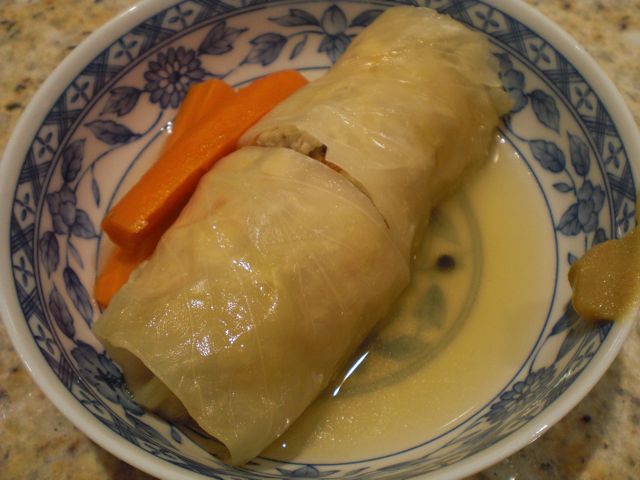
The amount below is four small Japanese size cabbage rolls.
Cabbage leaves: In large scale productions, you boil an entire large head of cabbage and then separate the individual leaves. For my small scale production and small-sized cabbage rolls, I separated each cabbage leaf by first cutting into the bottom veins and then using running water (introducing it between the leaves), to separate each leaf without tearing it. (I prepared 4 leaves). I used a rather small head of cabbage. I boiled the leaves in a large pan with salted boiling water for 10 minutes covered with a plate which fit snugly inside of the pan to keep all the leaves submerged during cooking. After the leaves were cool enough to handle I shaved off the large veins toward the bottom of the leaves without cutting through them (the #1 image below in the right back).
Stuffing: I finely minced onion (1/3 medium), carrot (1/2 medium), garlic (1 clove), and ginger (one thin slivers) which I sauteed in vegetable oil for few minutes and seasoned with salt and pepper and set aside to cool. You could also add shiitake mushroom, finely chopped, but I did not have one.
For the meat, I used trimmings from a pork tenderloin. I hand chopped it into ground pork (about 200 gram, I guess. The image #1). I mixed in the vegetables above,with bread crumbs (1/4 cup, I use panko, moistened with milk, the image #1 below in the left back). I added an egg (1 large) and seasoned it with freshly ground nutmeg, salt and black pepper. I mixed it well until the stuffing become elastic and hung together.
Assembly: As seen in the image #2, I made a small cylinder and placed it closed to the root end of the precooked cabbage leaf and rolled with the both side tucked in and made four rolls. Try not to over stuff the cabbage (the image below #3). (I had some stuffing left over. I made small patties and cooked it like a hamburger and braised it with mirin and soy sauce in teriyaki style. I served it with the side of a Japanese coleslaw. I forgot to take a picture)
Cooking: I used a Japanese-Western hybrid broth. I used Swanson non-fat reduced salt chicken broth and added bay leaves, sake, whole black pepper corns and a half a carrot (left over from the above). The cabbage rolls should fit snugly submerged in the cooking liquid (the image below #4). Of course, you could cook the cabbage rolls in "Oden" broth or tomato sauce if you like. On a very low flame, I gently simmered it with the lid mostly on and when it started boiling, I set the lid slightly askew and cooked for 40-50 minutes (I added more sake in the middle to compensate for the evaporation).
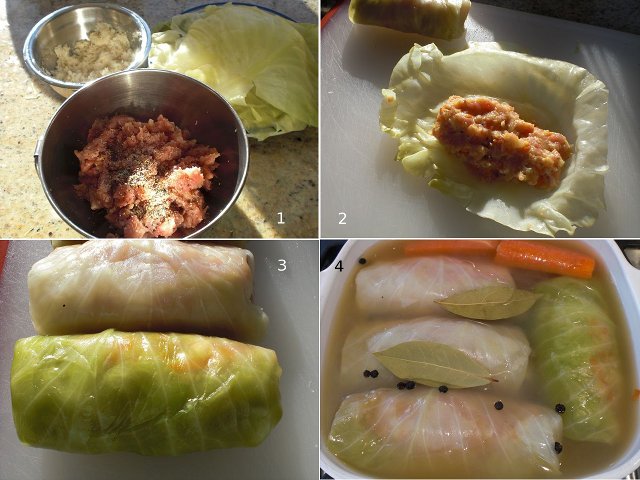
Here is the cut surface after cooking.
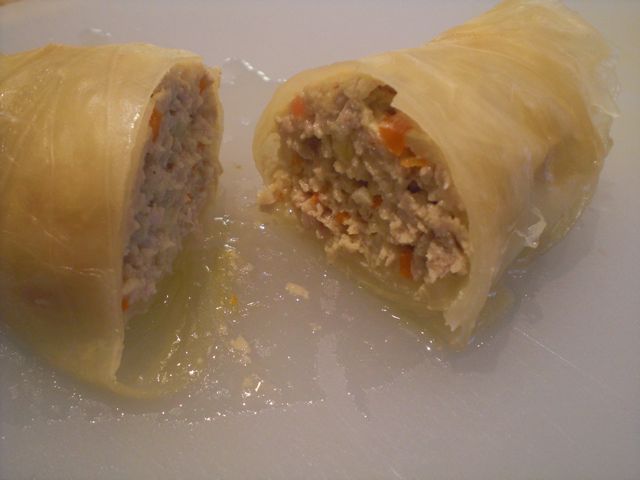
I served it in a small bowl with some broth and a small dab of Japanese hot mustard as would be used for oden. The stuffing was very tender and fluffy with very subtle rich flavor. The pork did not have a porky taste and seemed more like chicken. It was permeated with an interesting amalgamation of western and eastern flavors. The cabbage was also nicely cooked and not too strong. It was very soft, so much so you could cut the rolls with chopsticks. The hot Japanese mustard gave it a contrasting sharp jolt. Even my wife liked this one (it passed our "Mikey likes it" test). She particularly liked the light texture which was so different from the dense heavy classic stuffed cabbage with tomato sauce she learned to dislike as a kid. This dish will go with almost any drink but chilled G-sake was our choice.

Cabbage leaves: In large scale productions, you boil an entire large head of cabbage and then separate the individual leaves. For my small scale production and small-sized cabbage rolls, I separated each cabbage leaf by first cutting into the bottom veins and then using running water (introducing it between the leaves), to separate each leaf without tearing it. (I prepared 4 leaves). I used a rather small head of cabbage. I boiled the leaves in a large pan with salted boiling water for 10 minutes covered with a plate which fit snugly inside of the pan to keep all the leaves submerged during cooking. After the leaves were cool enough to handle I shaved off the large veins toward the bottom of the leaves without cutting through them (the #1 image below in the right back).
Stuffing: I finely minced onion (1/3 medium), carrot (1/2 medium), garlic (1 clove), and ginger (one thin slivers) which I sauteed in vegetable oil for few minutes and seasoned with salt and pepper and set aside to cool. You could also add shiitake mushroom, finely chopped, but I did not have one.
For the meat, I used trimmings from a pork tenderloin. I hand chopped it into ground pork (about 200 gram, I guess. The image #1). I mixed in the vegetables above,with bread crumbs (1/4 cup, I use panko, moistened with milk, the image #1 below in the left back). I added an egg (1 large) and seasoned it with freshly ground nutmeg, salt and black pepper. I mixed it well until the stuffing become elastic and hung together.
Assembly: As seen in the image #2, I made a small cylinder and placed it closed to the root end of the precooked cabbage leaf and rolled with the both side tucked in and made four rolls. Try not to over stuff the cabbage (the image below #3). (I had some stuffing left over. I made small patties and cooked it like a hamburger and braised it with mirin and soy sauce in teriyaki style. I served it with the side of a Japanese coleslaw. I forgot to take a picture)
Cooking: I used a Japanese-Western hybrid broth. I used Swanson non-fat reduced salt chicken broth and added bay leaves, sake, whole black pepper corns and a half a carrot (left over from the above). The cabbage rolls should fit snugly submerged in the cooking liquid (the image below #4). Of course, you could cook the cabbage rolls in "Oden" broth or tomato sauce if you like. On a very low flame, I gently simmered it with the lid mostly on and when it started boiling, I set the lid slightly askew and cooked for 40-50 minutes (I added more sake in the middle to compensate for the evaporation).
Two days later, we reheated the cabbage rolls with snap peas. It tasted even better.
Tuesday, April 13, 2010
Deep fried fish and mountain potato dumpling 薩摩揚げ(もどき)
"Satsuma-age" 薩摩揚げ is a deep fried fish cake which originated from the "Satsuma" 薩摩 region of Kyushu 九州, the southern island of Japan. This is often served in Izakaya. We occasionally have this as a "robatayaki" 炉端焼き item at Tako Grill. At home, I, like most people, ususally buy pre-made and frozen fish cakes. Just before serving, I thaw and grill (or toast them in a toaster oven). We eat these with grated ginger and soy sauce, which is pretty good. Another common use is to put them in "oden" おでん.
Since I bought a whole red snapper, I ended up with small bits of fish meat as well as meat I scraped off the bones after I filleted the fish. If this had been a salmon, I could have made a "salmon" cake in a very similar manner to "crab" cake. Although I never made this type of fish cakes before, I decided to make these fish meat scraps into a "Satsuma age". Mark's book p44 has a rather sophisticated version of this dish. I decided to use a simpler recipe which was in one of my cookbooks. In any case, I had only fish meat from red snapper but, typically, you should have a combination of two or more fish, usually cod plus some other white flesh fish to achieve good texture and taste according to these recipes. So, I knew mine would not be great before I even started making it.
First, I should have used a lower temperature oil and I should have used more fish meat or less egg white, liquid and grated nagaimo. Although this was quite edible (and my wife said it was even good) it is not "Satsuma age"--the consistency is totally wrong, much lighter and fluffier. I would call this "fried fish and nagaimo dumpling". I do not think I will make this one again. Store bought frozen ones are just fine.
Saturday, November 27, 2010
Nabemono 鍋物
Nabe 鍋 means "pot". Nabemono is an all inclusive term of any hot pot dish but often the dish itself is called "nabe". Any dish you cook (usually on the table) in a pot (most often earthenware) with broth is called "nabe" or "nabemono". Sukiyaki すき焼き, shabu-shabu しゃぶしゃぶ and oden おでん may be considered types of nabe in a broad sense but I do not think it is appropriate to include them in "nabemono". Depending on the ingredients and seasoning of the broth, you have many variations and many names of "nabe". Whatever the name, in cold winter days, nabemono is one of the most comforting and warming dishes. The types of broth seasonings could be;
Since other ingredients will impart lots of flavor to the broth, the starting broth is usually a simple kelp broth. In terms of the ingredients, you could limit them to only a few items (like yudoufu in which only tofu or tofu and nappa cabbage are usually used) or you could add anything including sea food, meat, vegetables, tofu, fish cake and more, as is done in chankonabe and yosenabe. There are no rules (although there are some guide lines). The name of the nabe changes based on the ingredients, locality, and types of broth.
Here is one example I made one evening in a small one person pot. I am not sure what I should call this. A type of yosenabe but I used mostly vegetables and at the very end decided to add shrimp. I first made dashi from kelp and a "dashi pack". This is like a tea bag but instead of tea, combination of pulverized bonito flakes, dried fish and kelp (there are several different kinds) are placed in the bag. It is much better than granulated instant dashi but still very convenient. I seasoned the broth with mirin, sake and soy sauce (to taste, since I did not measure). I started with the ingredients which take the longest time to cook. In my case, I added daikon (halved and thinly sliced) and carrot (sliced a bit thicker than the daikon) first, then after 10 minutes or so, I added the white part of Nappa cabbage or Hakusai 白菜, tofu 豆腐, followed by (after 5 minutes) maitake mushroom 舞茸, green parts of Nappa, scallion, and finally shrimp.
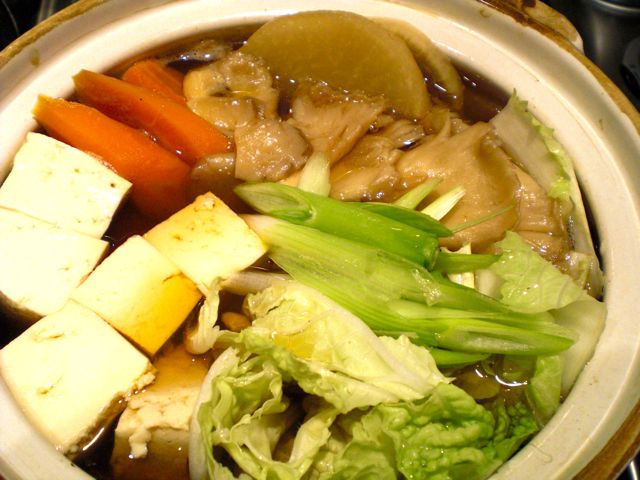
The ingredients I could have added include fish (usually a white meat, hardy fish such as cod), chicken (cut up thigh meat), fish cakes, and shell fish. As a condiment, I used seven flavored Japanese red pepper powder 七味唐辛子. To finish the meal, I could have added cooked rice to make porridge, or noodles such as udon noodles but I was too full just eating the items I cooked. Traditionally, warm sake is the choice of drink but we like cold sake even in winter and with nabe.
1) Dashi without seasoning; When your broth is not seasoned, you use a dipping sauce such as ponzu. Tarachirinabe タラちり鍋. Mizutaki 鶏の水炊き, and Yudoufu 湯豆腐 are three such examples.
2) Dashi and soy sauce based; Yosebabe 寄せ鍋 is the best example.
3) Dashi and miso based; Chankonabe ちゃんこ鍋, Ishikarinabe 石狩鍋, and Dotenabe 土手鍋 are three such examples.
Since other ingredients will impart lots of flavor to the broth, the starting broth is usually a simple kelp broth. In terms of the ingredients, you could limit them to only a few items (like yudoufu in which only tofu or tofu and nappa cabbage are usually used) or you could add anything including sea food, meat, vegetables, tofu, fish cake and more, as is done in chankonabe and yosenabe. There are no rules (although there are some guide lines). The name of the nabe changes based on the ingredients, locality, and types of broth.
Here is one example I made one evening in a small one person pot. I am not sure what I should call this. A type of yosenabe but I used mostly vegetables and at the very end decided to add shrimp. I first made dashi from kelp and a "dashi pack". This is like a tea bag but instead of tea, combination of pulverized bonito flakes, dried fish and kelp (there are several different kinds) are placed in the bag. It is much better than granulated instant dashi but still very convenient. I seasoned the broth with mirin, sake and soy sauce (to taste, since I did not measure). I started with the ingredients which take the longest time to cook. In my case, I added daikon (halved and thinly sliced) and carrot (sliced a bit thicker than the daikon) first, then after 10 minutes or so, I added the white part of Nappa cabbage or Hakusai 白菜, tofu 豆腐, followed by (after 5 minutes) maitake mushroom 舞茸, green parts of Nappa, scallion, and finally shrimp.
Thursday, December 7, 2023
Electric Sake Warmer 電気酒燗器
We usually drink sake cold. For drinking sake cold, we like a crisp, clean, and fruity flavor profile of daiginjo 大吟醸. Some junmai 純米 and junmai ginjo 純米吟醸 sakes also have this flavor profile. Our house sake, curretly, is “Tengumai 50 Junmai Daiginjo” 天狗舞純米大吟醸. We enjoy it cold and it has a nice clean, dry, crisp, and fruity flavor. Now, not going into the details, somehow, by mistake (not mine), we ended up with a case of “Tengumai yamahai-shikomi junmai”天狗舞山廃仕込純米 instead of our favored house sake. As I mentioned previously this sake has a more savory, yeasty and mushroomy flavor when tasted cold or at room temperature. Then I read that this sake changes its flavor profile if heated. Almost in desperation, we tried it warm (at 120F or “Atsu-kan” 熱燗). We were pleasantly surprised that the flavor profile changed completely and became smooth and mild. We thought “Ah-Ha” the secret is that this sake should be consumed warm which would be particularly appropriate during the winter months when we have dishes like hot pot “nabe” 鍋 dishes, “sukiyaki“ すき焼き, or “oden” おでん. But the main reason we rarely drink sake warm is that one additional step of warming it up and the difficulty of maintaining the temperature while enjoying it warm. So, we decided to splurge on an electric sake warmer 電気酒燗器.
We bought it at Amazon but it came from a seller in Japan. The sake warmer sits on top of the heating unit. The server holds about 240ml (1号半). It heats up to the specified temperature in10-15 minutes. The temperature control is continuous (not discreet steps) and ranges from about 35C to 60C (95F to 140F). Using my digital thermometer and water, the actual temperatures are higher (by about 5-10F) than it indicated. We usually like “Atsu- kan” *.
*ranges of warm sake temperature
“Jouon” 常温, room temperature 20℃ (68F)
”Hinata kan” 日向燗 sunny side 30℃ (86F)
”Hitohada kan” 人肌燗 skin temperature 35℃ (95F)
”Nuru kan” ぬる燗 luke warm 40℃ (104F)
”Jou kan” 上燗 warm 45℃ (113F)
”Atsu kan” 熱燗 hot 50℃ (122F)
The sake warmer works extremely well. We can have it sitting next to us and as we are enjoying the warm sake, we can add more sake to the server. By the time we are ready for the next serving, the sake has reached the proper temperature. The only challenge is to warm up enough but not too much sake and to consume it at just the peak of time it has been warming. This is because any leftover sake once heated will not be good the next day for example. Also,warming up the sake and keeping it warm more than 1 hour is not good either. In any case, this was a great improvement break through. We are glad that we can now enjoy Tengumai junmai sake this way. So the mistake which had us end up with a case of tengumai-junmai instead of our favored house sake was indeed a “blessing in disguise”. It introduced us to a sake variation which we now enjoy but would never otherwise thought of trying.
We bought it at Amazon but it came from a seller in Japan. The sake warmer sits on top of the heating unit. The server holds about 240ml (1号半). It heats up to the specified temperature in10-15 minutes. The temperature control is continuous (not discreet steps) and ranges from about 35C to 60C (95F to 140F). Using my digital thermometer and water, the actual temperatures are higher (by about 5-10F) than it indicated. We usually like “Atsu- kan” *.
*ranges of warm sake temperature
“Jouon” 常温, room temperature 20℃ (68F)
”Hinata kan” 日向燗 sunny side 30℃ (86F)
”Hitohada kan” 人肌燗 skin temperature 35℃ (95F)
”Nuru kan” ぬる燗 luke warm 40℃ (104F)
”Jou kan” 上燗 warm 45℃ (113F)
”Atsu kan” 熱燗 hot 50℃ (122F)
The sake warmer works extremely well. We can have it sitting next to us and as we are enjoying the warm sake, we can add more sake to the server. By the time we are ready for the next serving, the sake has reached the proper temperature. The only challenge is to warm up enough but not too much sake and to consume it at just the peak of time it has been warming. This is because any leftover sake once heated will not be good the next day for example. Also,warming up the sake and keeping it warm more than 1 hour is not good either. In any case, this was a great improvement break through. We are glad that we can now enjoy Tengumai junmai sake this way. So the mistake which had us end up with a case of tengumai-junmai instead of our favored house sake was indeed a “blessing in disguise”. It introduced us to a sake variation which we now enjoy but would never otherwise thought of trying.
Saturday, September 16, 2017
Hanpen stuffed with cheese はんぺんのチーズ焼き
This is a slight variation on what I posted before. "Hanpen" fish cake stuffed with cheese cooked with olive oil and seasoned. I served this with chicken liver simmered in red wine as a starter one evening.
When I made oden おでん a few days ago, I used kelp to make broth. I recycled the used kelp into "tsukudani" 昆布の佃煮 and used it as a topping.
The cheese melted nicely and this was also seasoned with concentrated noodle sauce and grated ginger.
This is the second time I made this chicken liver dish. Although the liver was a bit mangled up into pieces rather than whole lobes and it may not have looked as nice as the last batch I made, it still tasted really good. The red wine I used this time was California cab (I think it was Louis M Martini Cab from Napa 2014). It is not as tannic as what I used last time and the overall dish came out better than the first batch.
I just thawed the "hanpen" fish cake. Cut it into 4 pieces and made a pocket using a small knife and stuffed the pocket with cheese (I think I used double Gloucester). I fried both sides in a small amount of olive oil until golden and the cheese melted. I added a small amount of concentrated noodle sauce (or soy sauce). I added a dab of grated ginger and the kelp tsukudani. This combination is always good. The kelp's slight saltiness went well.
When I made oden おでん a few days ago, I used kelp to make broth. I recycled the used kelp into "tsukudani" 昆布の佃煮 and used it as a topping.
The cheese melted nicely and this was also seasoned with concentrated noodle sauce and grated ginger.
This is the second time I made this chicken liver dish. Although the liver was a bit mangled up into pieces rather than whole lobes and it may not have looked as nice as the last batch I made, it still tasted really good. The red wine I used this time was California cab (I think it was Louis M Martini Cab from Napa 2014). It is not as tannic as what I used last time and the overall dish came out better than the first batch.
I just thawed the "hanpen" fish cake. Cut it into 4 pieces and made a pocket using a small knife and stuffed the pocket with cheese (I think I used double Gloucester). I fried both sides in a small amount of olive oil until golden and the cheese melted. I added a small amount of concentrated noodle sauce (or soy sauce). I added a dab of grated ginger and the kelp tsukudani. This combination is always good. The kelp's slight saltiness went well.
Subscribe to:
Posts (Atom)





